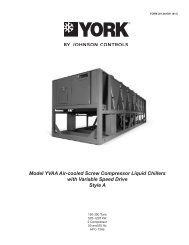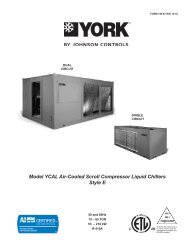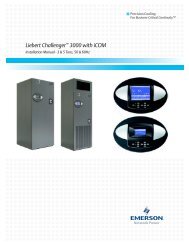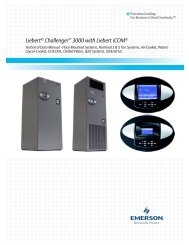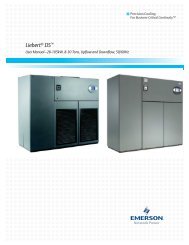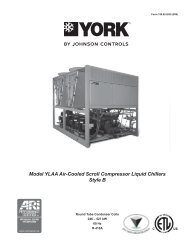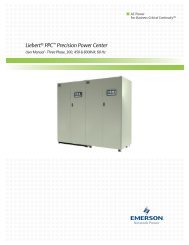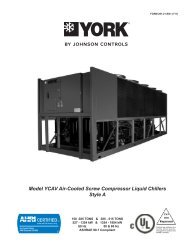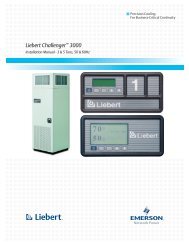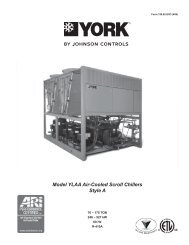Liebert Challenger 3000
Liebert Challenger™ 3000 Operation & Maintenance Manual - DCES
Liebert Challenger™ 3000 Operation & Maintenance Manual - DCES
Create successful ePaper yourself
Turn your PDF publications into a flip-book with our unique Google optimized e-Paper software.
6.4.4 Thermostatic Expansion ValveOperationComponent Operation and MaintenanceThe thermostatic expansion valve performs one function. It keeps the evaporator supplied withenough refrigerant to satisfy load conditions. It does not effect compressor operation.Proper valve operation can be determined by measuring superheat. If too little refrigerant is being fedto the evaporator, the superheat will be high; if too much refrigerant is being supplied, the superheatwill be low. The correct superheat setting is between 10 and 15°F (5.6 and 8.3°C).AdjustmentTo adjust the superheat setting, proceed as follows:1. Remove the valve cap at the bottom of the valve.2. Turn the adjusting stem counterclockwise to lower the superheat.3. Turn the adjusting stem clockwise to increase the superheat.NOTEMake no more than one turn of the stem at a time. As long as 30 minutes may be requiredfor the new balance to take place.6.4.5 Hot Gas Bypass ValveOperationThe hot gas bypass is inserted between the compressor discharge line and the leaving side of theexpansion valve through the side outlet distributor. The system, with normal operation when theevaporator is under full load, will maintain enough pressure on the leaving side of the hot gas valve tokeep the valve port closed.If the load on the evaporator decreases, the evaporator will get colder. When the coil is too cold, theinternal pressure in the evaporator drops and allows the hot gas bypass valve to open. Hot gas thenmixes with the liquid coolant on the discharge side of the expansion valve raising the temperatureand pressure in the evaporator. The net result is a reduction in the cooling capacity of the unit tomatch the load.To aid in lubricating the compressor, the hot gas bypass solenoid is delayed for 30 seconds on the initialcall for cooling and de-energized for 30 seconds during every 60 minutes of continuous operation.AdjustmentUpon deciding what evaporator temperature is desired, the following procedure should be used toadjust the hot gas bypass valve:1. Install the suction and discharge pressure gauge.2. Adjust the temperature setpoint to call for cooling so that the refrigeration compressor will run.3. Remove the TOP adjusting nut from the valve.4. Insert an Allen wrench in the brass hole at top of the valve in adjusting port, and turnCLOCKWISE if a higher evaporator temperature is required.5. After obtaining the suction pressure required, reinstall the cap tightly making sure there are noleaks.6. Let the evaporator operate for approximately 10 to 15 minutes to make sure the suction pressureis within the desired range.7. There will be a fluctuation of approximately 3 to 6 PSIG (21 to 41 kPa) on the evaporator due tothe differential on the hot gas bypass.8. Return the temperature setpoint to desired number.47



